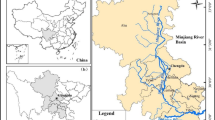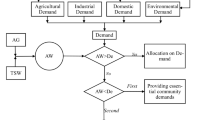Abstract
This paper proposes a mathematical model for allocating water to stakeholders of a shared watershed. Each stakeholder in the basin has a water demand and a water profit; however, the available water cannot meet the demands of all stakeholders. This shortage raises a conflict between stakeholders as they use a common resource. To reach an agreement between the stakeholders in water allocation, first a model was developed to obtain the highest possible profit that a stakeholder can achieve if the stakeholder is allowed to utilize as much as possible water after satisfying the basin environmental demands (flows). Then, another model was introduced which allocates water to each stakeholder such that the minimum ratio of stakeholders’ profits to their highest possible profits is maximized. It is shown that the obtained solution is non-dominated in terms of considering each stakeholder profit as an objective, which means that none of the objective functions can be improved in value without degrading some of the other objective values. The proposed method is applied to the Sefidrud River basin, which is one of the biggest rivers in Iran. The stakeholders of this basin are eight administrative provinces that compete for utilizing more water while the Basin’s water resources could not satisfy all stakeholders’ water requirements. The model’s results show that it can successfully be used for sustainable conflict resolution in a shared basin because the model satisfies the environmental water requirement in the entire basin and provides equitably the same ratio of the stakeholders’ highest possible profits for them. For the case of this study, the proposed approach allocates water to the stakeholders in such a way that they could obtain at least 65 % of their highest possible profits in average.




Similar content being viewed by others
References
Afshar, A., Sharifi, F., & Jalali, M. R. (2009). Non-dominated archiving multi-colony ant algorithm for multi-objective optimization: Application to multipurpose reservoir operation. Engineering Optimization, 41(4), 313–325.
Ahmadi, A., Karamouz, M., Moridi, A., & Han, D. (2012). Integrated planning of land use and water allocation on a watershed scale considering social and water quality issues. Journal of Water Resources Planning and Management, 138(6), 671–681.
Brels, S., Coates, D., & Loures, F. (2008). Transboundary water resources management: the role of international watercourse agreements in implementation of the CBD. In Vol. 40 (pp. 48), Montreal, Canada.
Cai, X., McKinney, D. C., & Lasdon, L. S. (2002). A framework for sustainability analysis in water resources management and application to the Syr Darya Basin. Water Resources Research, 38(6), 211–2114.
Cohon, J. L., & Marks, D. H. (1975). A review and evaluation of multiobjective programing techniques. Water Resources Research, 11, 208–220.
Devi, S., Srivastava, D., & Mohan, C. (2005). Optimal water allocation for the transboundary Subernarekha River, India. Journal of Water Resources Planning and Management, 131, 253–269.
Divakar, L., Babel, M. S., Perret, S. R., & Gupta, A. D. (2011). Optimal allocation of bulk water supplies to competing use sectors based on economic criterion—An application to the Chao Phraya River Basin, Thailand. Journal of Hydrology, 401(1–2), 22–35.
Divakar, L., Babel, M. S., Perret, S. R., & Gupta, A. D. (2013). Optimal water allocation model based on satisfaction and economic benefits. International Journal of Water, 7, 363–381.
Fattahi, P., & Fayyaz, S. (2010). A compromise programming model to integrated urban water management. Water Resources Management, 24(6), 1211–1227.
Fotakis, D., & Sidiropoulos, E. (2014). Combined land-use and water allocation planning. Annals of Operations Research, 219, 169–185.
Griffith, M., Codner, G., Weinmann, E., & Schreider, S. (2009). Modelling hydroclimatic uncertainty and short-run irrigator decision making: The Goulburn system. Australian Journal of Agricultural and Resource Economics, 53(4), 565–584.
Huang, Y., Li, Y. P., Chen, X., & Ma, Y. G. (2012). Optimization of the irrigation water resources for agricultural sustainability in Tarim River Basin, China. Agricultural Water Management, 107, 74–85.
IBM ILOG CPLEX Optimizer.
Jaramillo, P., Smith, R., & Andréu, J. (2005). Multi-decision-makers equalizer: A multiobjective decision support system for multiple decision-makers. Annals of Operations Research, 138, 97–111.
Kucukmehmetoglu, M., & Guldmann, J. (2004). International water resources allocation and conflicts: The case of the Euphrates and Tigris. Environment and Planning A, 36(5), 783–801.
Kucukmehmetoglu, M., & Guldmann, J. (2010). Multiobjective allocation of transboundary water resources: Case of the Euphrates and Tigris. Journal of Water Resources Planning and Management, 136(1), 95–105.
Kundzewicz, Z. W., & Kindler, J. (1995). Multiple criteria for evaluation of reliability aspects of water resource systems. Proceedings of a Boulder Symposium, Colorado, 231, 217–224.
McKinney, D. C., & Cai, X. (1997). Multiobjective optimization model for water allocation in the Aral Sea Basin. In 3rd Joint USA/CIS joint conference on environmental hydrology and hydrogeology, pp. 44–48.
MGC (Mahab Ghods Company)(2011). National water master plan study: The Sefidrud Basin (technical report). Tehran: Iranian Ministry of Energy.
Plà, L. M., Sandars, D. L., & Higgins, A. J. (2013). A perspective on operational research prospects for agriculture. Journal of the Operational Research Society, 65, 1078–1089.
Pulido-Velázquez, M., Andreu, J., & Sahuquillo, A. (2006). Economic optimization of conjunctive use of surface water and groundwater at the basin scale. Journal of Water Resources Planning and Management, 132, 454–467.
Reca, J., Roldán, J., Alcaide, M., López, R., & Camacho, E. (2001). Optimisation model for water allocation in deficit irrigation systems: I. Description of the model. Agricultural Water Management, 48(2), 103–116.
Rezapour Tabari, M. M., & Yazdi, A. (2014). Conjunctive use of surface and groundwater with inter-basin transfer approach: Case study Piranshahr. Water Resources Management, 28, 1887–1906.
Roozbahani, R., Schreider, S., & Abbasi, B. (2013). Economic sharing of basin water resources between competing stakeholders. Water Resources Management, 27(8), 2965–2988.
Schlüter, M., Savitsky, A. G., McKinney, D. C., & Lieth, H. (2005). Optimizing long-term water allocation in the Amudarya River delta: A water management model for ecological impact assessment. Environmental Modelling & Software, 20(5), 529–545.
Tennant, D. L. (1976). Instream flow regimes for fish, wildlife, recreation and related environment resourcce. Fisheries, 1(4), 6–10.
Torabi Palatkaleh, S., Estiri, K., & Hafez, B. (2010a). The role of environmental requirements in process of water allocation for watersheds in Iran: Sustainable development approach. In 2nd International conference water, ecosystems and sustainable development in arid and semi-arid zones, Tehran.
Torabi Palatkaleh, S., Roozbahani, R., Hobevatan, M., & Estiri, K. (2010b). Water allocation regulation. Tehran: Iranian Ministry of Energy.
UNESCAP. (2000). Principles and practices of water allocation among water-use sectors. Bangkok: United Nations, Economic and Social Commission for Asia and the Pacific.
Wang, L., Fang, L., & Hipel, K. W. (2004). Lexicographic minimax approach to fair water allocation problems. In Conference proceedings—IEEE international conference on systems, man and cybernetics, Vol. 1, pp. 1038–1043.
Zarezadeh, M., Morid, S., Madani, K., Salavitabar, A., & Hipel, K. W. (2012). Water allocation under climate change in the Qezelozan-Sefidrood Watershed. In Conference proceedings—IEEE international conference on systems, man, and cybernetics, pp. 2424–2428.
Acknowledgments
The authors are grateful to the anonymous referees and the editor for their numerous constructive and thoughtful comments that led to this improved version.
Author information
Authors and Affiliations
Corresponding author
Rights and permissions
About this article
Cite this article
Roozbahani, R., Abbasi, B. & Schreider, S. Optimal allocation of water to competing stakeholders in a shared watershed. Ann Oper Res 229, 657–676 (2015). https://doi.org/10.1007/s10479-015-1806-8
Published:
Issue Date:
DOI: https://doi.org/10.1007/s10479-015-1806-8






